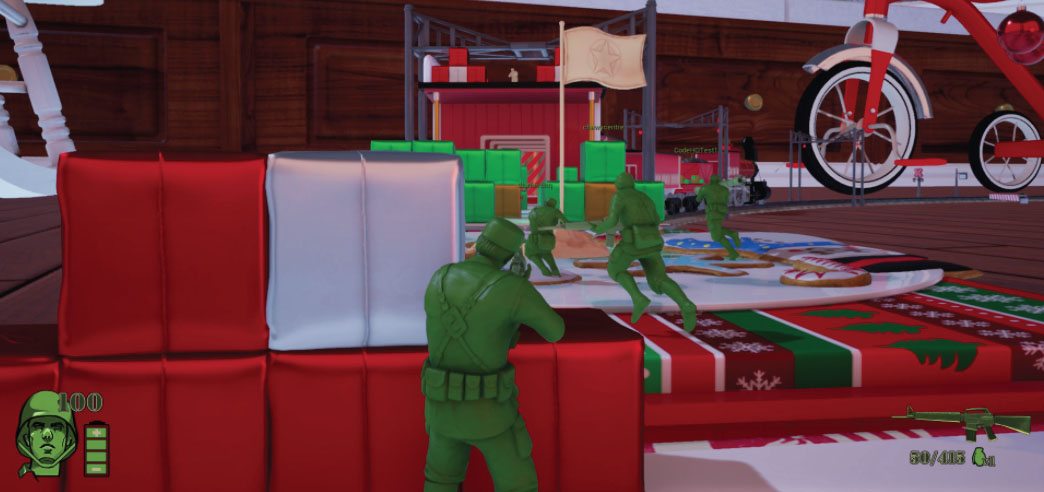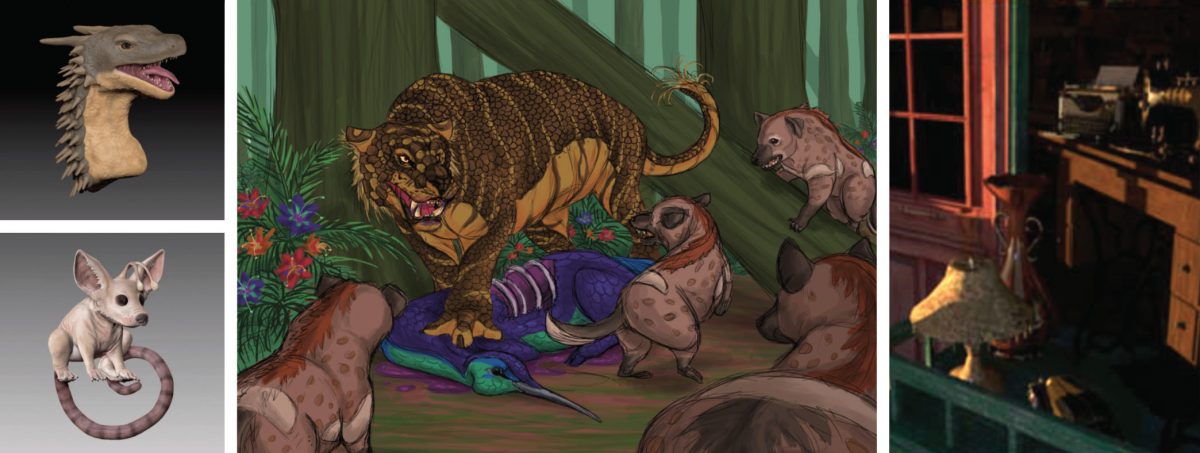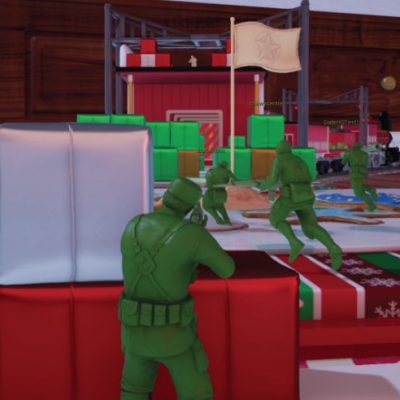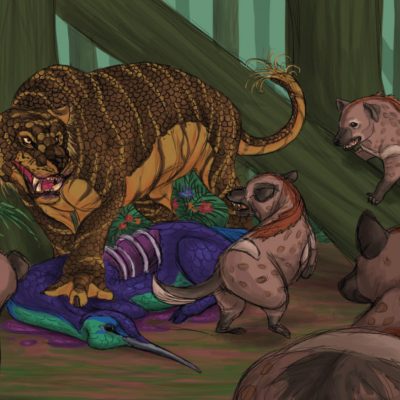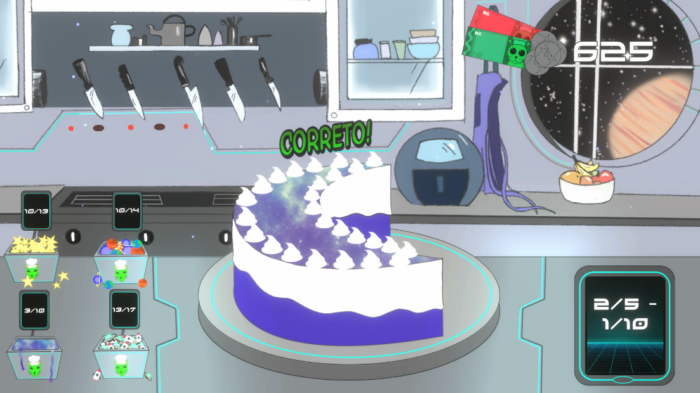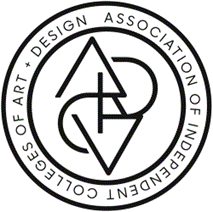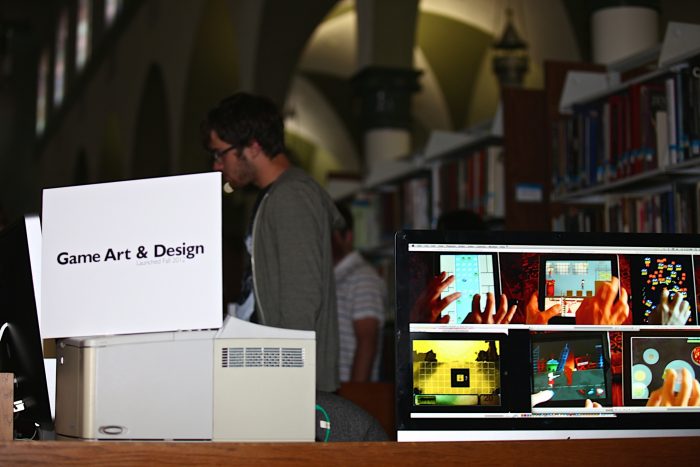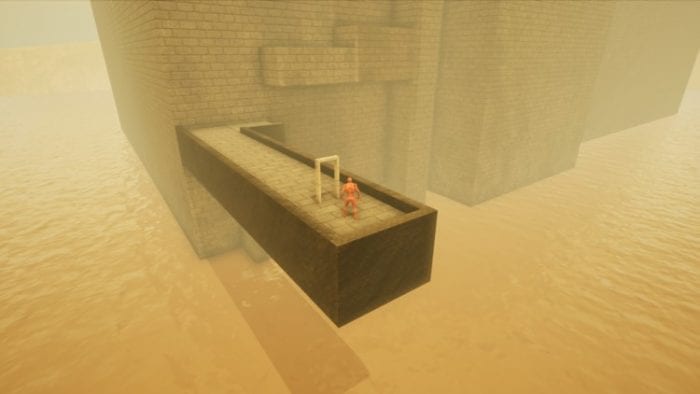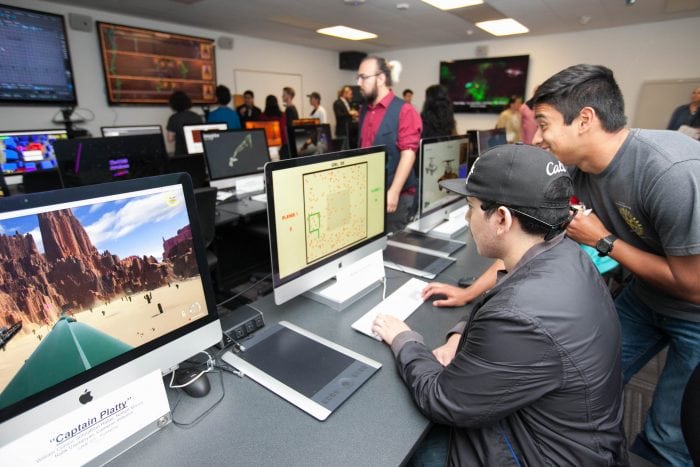School of Media : Culture : Design
Game Art & Design
Bachelor of Fine Arts [STEM Program]
The Game Art & Design program teaches students how to conceptualize and develop video games from scratch. The program is ranked among the top 25 nationally among schools offering a BFA by Animation Career Review. The Game Art & Design program combines art, animation, computer technology, sound design, story development and game design.
Apply Request Information Take a TourDesign your future
The Game Art & Design program offers specialized tracks for both artists and designers. All Game Art & Design students take game courses together while they simultaneously develop their own art or design specialties. Game art focuses on two-dimensional and three-dimensional character, environmental design and animation. Game design focuses on elements such as game conceptualization, play mechanics, game rules, story, program flow, scoring systems and prototyping.
The Game Art & Design program brings together art, animation, computer technology, sound design, storytelling and game design. It aligns with both the Applied Computer Science and the Animation programs, sharing many courses in their major sequence. Students work together in a cross-disciplinary team environment of artists and designers that mirrors the professional world. They learn to meet the challenges of a rapidly changing technology, both in the production and distribution of video games. Students learn to focus their professional skill set, as they discover and develop their own creative voice.
Top reasons to study at Woodbury:
- Location: Woodbury is surrounded by many commercial game development studios, both large and small.
- Enthusiasm: Woodbury’s faculty and students are crazy-mad about video games!
- Size: Woodbury’s small class sizes allow for hands-on, one-on-one interaction with our accomplished instructors.
- Demonstrated quality: National accreditation lets employers know that Woodbury has a high-quality program.
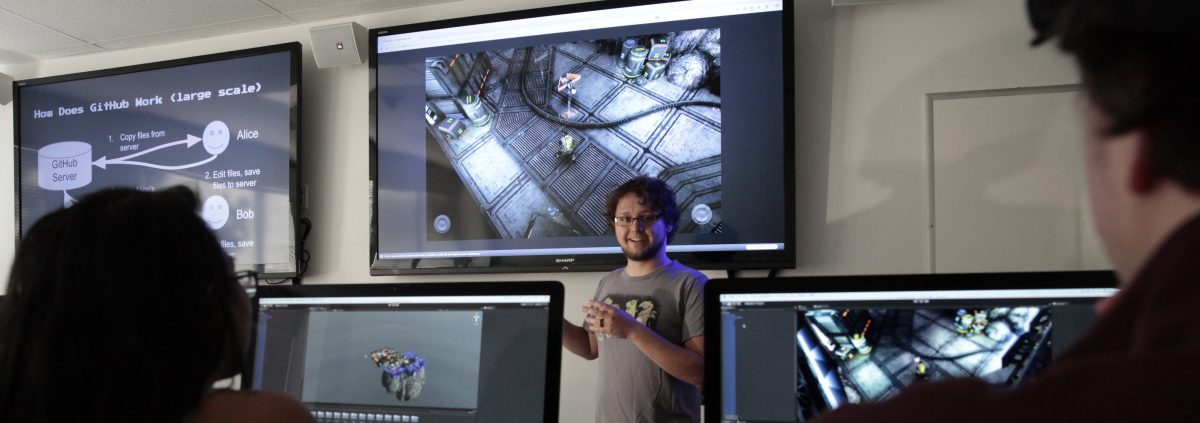
Internships & Careers
Internship opportunities:
- Nickelodeon
- Insomniac Games
- Activision Blizzard
- Disney
- Nexon
- Code Headquarters
- Skydance Interactive
- DICE LA
- AVR Studios
- Mobile Motion Mocap
- Containment Field LLC
- Get Dead Entertainment
- Lionsgate Entertainment
Internships are a required component of the BFA in Game Art & Design.
Career opportunities:
- Environmental design and modeler
- Character design and modeler
- 3D character animator
- Rigger
- Story development for interactive media
- Game designer
- Game level designer
- Scenario designer
- Combat designer
- User interface designer
- R&D prototype developer
- Game design documentation
Alumni Spotlight
Facilities
Game Art & Design studio courses are held in computer labs and dedicated studios. Lab Macs and PCs are loaded with industry-standard video game development software, plug-ins, apps, utilities and digital audio synthesizers.
Courses
The Game Art & Design curriculum examines all aspects of video game design and the creation of art and animation for games. Students may choose from two concentrations: Game Art, focusing on character and environmental design and animation; and Game Design, focusing on elements of design such as game conceptualization, play mechanic creation and prototyping.
GAME 101 Game Design Fundamentals
The study of game design using digital and non-digital games, both old and new. We examine introductory design topics and expand into the areas of procedural thinking, ideation, game prototyping, the balance between chance and skill, an examination of various design theories, and the ethical considerations of game design. As the basis of student critiques, games will be played and broken down into their formal, dramatic, and dynamic structural elements. Individually and in teams, students will design and develop games that are play-tested and critically reviewed in class. Studio. Prerequisite: None.
GAME 105 3D Art Fundamentals
Game art in three dimensions. An introduction to game production workflow techniques, time management, and the terminology of 3D design principles. Level-of-detail exercises will explore the concepts of polygon topology, image budgets, initial sketching and brainstorming, pre-visualization, hard surface construction, and spatial relationships with regard to the human factor of scale. Studio. Prerequisite: None.
GAME 107 Game Design Practices
In a broad overview format, students will investigate the video game industry’s standard practices employed in the creation of interactive computer software. Study includes various hardware and software technologies, their practical use and application, and the resulting work product as taught within the Game Design track. Students will ultimately determine the best track for them to pursue in their academic career: either Game Art or Game Design. Prerequisite: GAME Major
GAME 109 Game Art Practices
An introduction to today’s video game industry workflow techniques and 3D animation production methods. Studies include the study of 3D design principles and terminology, efficient polygon hard surface construction, implementation of UV layout techniques, digital high-resolution sculpting practices, proficient re-topology creation, digital painting and texturing techniques, traditional key-frame animation, and rendering techniques.
Prerequisite: GAME Major
GAME 112 Game Design Documentation
The life of a video game design from initial conceptualization to the final written production specification. We will trace the creation of an initial game idea through a High Concept and “pitch” phase to the writing of a Game Design Document (a.k.a. GDD). We will explore the purpose of design documentation, its maintenance, and its use in professional software development. Techniques for version control, the handling of design artifacts, and redundant data will be practiced. Students will develop a GDD of their original concepts and prepare them for executive-style presentations.
GAME 201 Narrative Design Fundamentals
Students will study the structures, styles, rhythms, and principles of story development, and how it can translate between various forms of media. Focus is on story structure, breathing life into compelling characters, crafting genuine dialog, consistency of voice & points of view, and building fictional worlds. Through in-class readings, active development, and group critiques of student work, student world-builders will learn and implement the fundamental tenants of crafting powerful stories, regardless of media platform. Prerequisite: WRIT 112 or WRIT 113.
GAME 203 Sound Design Fundamentals
A hands-on study of the scientific, psychological, and transcendental qualities of sound, and its effective use in the arts. With an emphasis on applied practice, topics include synthetic vs. real-world sound, psychoacoustics, the overtone series of periodic waveforms, harmonic analysis and timbre, composite sound effects, additive and subtractive synthesis, plus digitally modeling and altering the acoustic behavior of traditional musical instruments. Students will use advanced sound design and production software to create original soundscapes, music, and sound effects for use in their interactive media projects.
Prerequisite: GAME 101 Game Design Fundamentals.
GAME 140 Environmental Design & Modeling
Game artists learn to create worlds. An examination and practice of industrial and architectural design principles and pre-visualization workflow techniques for creating interior and exterior 3D assets to support game design courses. Students will use 2D and 3D software to design and build environments, set dressing, and vehicles. Continued practice with level-of-detail exercises will further develop polygonal hard-surface construction with the implementation of UV set techniques, function integrity, asset modularity, and spatial relationships with regard to the human factor of scale.
Studio. Prerequisite: GAME 105, 3D Game Fundamentals.
GAME 237 Materials, Lighting, & Rendering
The study of virtual light, texturing, and performance considerations. Students will explore game project development from initial concept to final production employing simulated, realistic lighting techniques to effectively convey the desired mood and ambiance of a scene. Further study includes
function integrity, composition, and 3D camera properties, such as depth of field, custom material channels, and specialized textures, with special attention to rendering performance considerations. Continued level of detail exercises will develop vertex coloring and texture baking techniques, ambient occlusion, global illumination, light exclusivity, shadow quality, image budgets, and advanced lighting systems and rendering techniques. Studio. Prerequisite: GAME 140, Environmental Design & Modeling.
GAME 238 Character Design & Modeling
The creation of organic 3D models. Students will develop the knowledge and technical skills necessary to translate a concept into a digital 3D organic sculpture. Use of various alternative software will develop a clear understanding of how human anatomy relates to 3D organic modeling. Emphasis is on learning the industry standard best-practices for efficient polygonal organic modeling, proper construction of edge loops to create shape and form, the importance of multiple tile UV sets, retopology of high-resolution models, and 3D digital painting and texturing techniques. Studio. Prerequisite: GAME 237, Materials, Lighting, & Rendering.
GAME 303 Advanced 3D Sculpting
This course builds on all the learned skills from the previous digital 3D organic character sculpting course. Emphasis is on further developing skills and refinement techniques to create the ultra-realistic aspects of shape, form, and proportions in human anatomy. Rapid prototyping techniques, application, and integration of hard surface accessories, hair, and fabrics to enhance the asset creations in the 3D digital sculpting process.
Prerequisite: GAME 237 Materials, Lighting & Rendering
GAME 307 Character Rigging
Working with 3D models created in their previous Character Design & Modeling course, students will develop creative animation strategies that are driven by logic, intuition, imagination, and systemic reasoning. The goal of study is to define a hierarchical set of interconnected bones, or “rigs”. By manipulating these rigs, students will learn how to demonstrate, document and prepare a modeled 3D character for the desired joint articulations, body mechanics, and eventual animation. Focus is on the inventive planning of a set of animation-control “rig handles” that students will use to realize complex and expressive character animations in subsequent 3D game art courses. Studio, Prerequisite: GAME 238 Character Design & Modeling
GAME 308 3D Cinematic Animation
Bringing life to three-dimensional objects. Students will study and practice the integration of 3D animation production methods and techniques used in today’s video game industry. Studies include the integration of motion-capture data and traditional key-frame animation into game engine production pipelines. Students will demonstrate how forward and inverse kinematics systems relate to body mechanics in order to effectively express a complex 3D animation network. Prerequisite: GAME 307 3D Character Rigging
GAME 309 3D Game Animation
Bringing life to three-dimensional objects. Students will study and practice the integration of 3D animation production methods and techniques used in today’s video game industry. Studies include the integration of motion-capture data and traditional key-frame animation into game engine production pipelines. Students will demonstrate how forward and inverse kinematics systems relate to body mechanics in order to effectively express a complex 3D animation network. Studio. Prerequisite: GAME 238, Character Design & Modeling.
GAME 312 Advanced 3D Hard Surface Modeling
A further examination and development of all learned skills in rapid prototyping and game production workflow techniques. Students will focus on advanced hard surface modeling techniques; UDM multi-UV layout techniques, 3D digital high-resolution sculpting and baking practices; development of custom PBR material node networks; and the storytelling application of realistic surface construction and digital painting details. Prerequisite: GAME 237 Materials, Lighting & Rendering
GAME 106 Game Code Fundamentals
Coding: Where the rubber meets the road. An introductory course in computer game programming for game designers, game artists, and other non-engineers. Using game engine software, students will design and create original playable games through code. Focus is on describing and creating world-defining systems by applying a wide range of coding techniques that can be used to create any type of video game, from text adventures to more complex physics simulations. Studio. Prerequisite: None.
GAME 114 Introduction to Game Engines
An examination of commercial software systems that aid in computer game development. This course is an exploration and analysis of visual development tools and reusable software components for game asset creation and management giving attention to 2D and 3D rendering performance, collision detection, simple scripting, animation, play mechanics, sound and music. Students will design and implement original game concepts and test for playability and design integrity. Studio. Prerequisite GAME 101, Game Design Fundamentals.
GAME 205 Game Engine Techniques
The course’s focus is on the practical use of the engine tools learned in GAME 114 – Game Engine Fundamentals, and their application to the common processes encountered over the course of commercial video game development. Guided, intensive exercises task students with devising creative implementations of topics that include: conceiving, designing, and balancing a combat system, creating real-time animation using motion-capture data, developing a polished cutscene with procedural camera control software, taking a level design from paper layout through to a polished scene using professional world-building tools, and developing specialized Artificial Intelligence modules for use in their games. Students develop these techniques as solo projects, implementing a unique world construct of their original designs. Each exercise builds upon the previous ones, culminating in a complete, playable and unique game concept realized by the end of the course.
GAME 207 Game Programming Patterns
Building on the foundations developed in GAME 106 – Game Code Fundamentals, Programming Patterns focuses on the underlying principles of data structures in computer science, and their application to key programming patterns commonly used in games. The emphasis is on programming for efficiency, readability, and reuse of code. Topics of study include data structure constructs, sorting algorithms, data storage structures, top-down manager scripts, inventory systems, artificial intelligence systems, and dynamic level loading schemes.
GAME 211 Level Design
The study and practice of composing 2D and 3D digital play environments. Students will break down components of select commercial game levels and evaluate their designs in terms of effective and ineffective constructs. Studio projects involve the creation of game levels that include top-down, platformer, horizontal/vertical scrollers, and first/ third person formats. Student-created levels will be play-tested in class and the success of their design intent will be assessed. Studio. Prerequisites:
GAME 221 Game Prototyping
Design assessment prior to production. Prototyping is that part of game development where designers and artists assess all aspects of a game design prior to full production. Attention is paid to issues of feasibility, practicality, and remedy of design flaws. Focus includes “fun factor,” development time, and overhead system resources. Techniques include paper prototyping, use of logic and flow charts, and advanced use of game engine software. Students will learn to prototype original game designs for group critique. Studio. Prerequisite: GAME 114, Introduction to Game Engines.
GAME 222 Game Player Analysis
When creating a video game, development teams often lose sight of what they are doing and why, and who they are doing it for. We will focus on the game player and how game creators can “play to their audience.” We will identify the types of players, why people play computer games, analyze player psychology, their data profiles, audience diversity, and its impact on the consumer marketing of video games. Lecture. Prerequisite: GAME 102, Game Design.
GAME 321 User Interface Design
Analysis of effective user interface design techniques and devices. Students will study the foundation of interaction design, graphic design, information architecture, and usability design to create effective video game interfaces. In addition to learning interface design methodologies and principles, students will also be introduced to industry standard software tools, along with contemporary UI design trends and practices in video game development. Students will produce several game interface design examples for their portfolio. Studio. Prerequisite: GAME 221, Game Prototyping.
GAME 322 Advanced Sound Design
Building on the foundation of GAME 203 Sound Design Fundamentals, students will design and construct unique and original audio assets and production devices in support of the composition of original long-form sonic pieces. Areas under study include abstract collages, traditional and experimental music composition, expressive narrative-driven soundscapes, compound sound effects, advanced audio production tools and techniques, and live performance of original compositions. Focus is on the integration of original assets and phrases with commercial audio assets and frameworks. Prerequisite: GAME 203 Sound Design Fundamentals
GAME 332 Experimental Technology for Games
Will this be the future of video games? An examination of the technologies of perception used to create immersive game experiences in the fields of virtual reality, mixed reality, augmented reality and alternate reality. We will explore the devices that exist today for enhancing the user’s perceptual experience and the fundamentals of the human sensory apparatus that drives them. Students will design and implement immersive experiences for a range of technology platforms aimed at increasing the player’s sensory experience. Studio. Prerequisite: GAME 221, Game Prototyping.
GAME 334 Procedural Toolsets
Procedural generation is a method of creating data with computer code rather than manually. It is usually implemented through a combination of human-generated assets and algorithms coupled with computer-generated randomness and processing power. Procedural tools allow students to leverage a small team or solo project development to build large worlds by harnessing this type of computer automation. The focus is on developing students’ skills with the emerging procedural software toolsets in widespread use throughout today’s video game industry. Areas of study include node-based systems for generating code-driven 3D models, systems that create tile-less visual materials, and artificial intelligence-driven mechanisms to generate unique concept art.
GAME 224 History of Games: 20th Century
The creation and evolution of video games in the twentieth century. We will examine the origin and development of digital games and their technology. Our study will begin with the World War II era and the invention of the electronic computing machine. Our exploration will continue with the early uses of electronics in games, the emergence of digital media in everyday life, the placement of powerful game computers in the home, and the creation and advances of the early Internet. Key games will be analyzed in terms of their social, cultural, and economic impact on our world. Lecture. GAME 224 and 226 may be taken in any order. Prerequisites: WRIT 112, Academic Writing II, or WRIT 212, Rhetoric and Design; and GAME 102, Game Design.
GAME 390 Internship
120 hours of work experience in the video game, entertainment, or interactive industry is required to graduate. Students must be at least in their junior year and in good academic standing to apply. The application process is the completion of a Game Art & Design Internship Contract signed by their faculty advisor, the department chair, and the host company’s supervisor. Grades are Pass/Fail and are based on a signed evaluation form from the company’s supervisor, and an internship journal maintained by the student. The journal details their hours, what they learned about the industry, and their expectations and thoughts on the experience. Students will formally share their findings with classmates. Prerequisites: Consent of chair, Game Art & Design majors only.
GAME 431 Degree Project: R&D
Through lectures, self-directed study and research, student teams develop a Proposal and Project Plan for a substantial original work of interactive media. Students will develop a Proposal that describes in detail the scope and nature of the digital media project that is to be produced for their Degree Project. Focus is on creating comprehensive game design documentation, and a complete Art Style Guide of the proposed project. Students will deliver their Proposal in a scripted, formal presentation to students and faculty. Projects approved by the department Chair will undergo a planning phase. Students develop an inclusive Production Schedule that includes task breakdowns & assignments, dates & itemization of deliverables, asset creation contingencies, prototyping of key interactive features and playtesting. Studio. Prerequisite: Consent of department chair.
GAME 432 Degree Project: Production
Students implement their Project Plan of an original video game or interactive media that was developed and approved in the previous semester’s Research & Development effort. Special attention will be paid to the effective use of technology, schedule slippage, high-risk areas, weekly progress, playtesting, iteration, and the practicality of the original design intent. Degree Projects are formally presented and assessed in a final faculty review. Assessment points include effective and creative use of technologies, the quality of problem solving, design thinking throughout the production cycle, usability, professionalism, and the ultimate success of project management planning. Studio. Prerequisites: Consent of department chair, GAME 431, Degree Project: R&D.
GAME 434 Professional Practices of the Game Industry
Students prepare for the challenges of finding a job and succeeding in the competitive video game industry. Topics include the current economics and structure of the industry, roles and skill sets within team structures, creative processes, and business practices such as publishing and marketing. Students will develop their career goals and their ability to effectively assess prospective employers to identify the best possible matches. Studio. Prerequisites: Consent of department chair, GAME 431, Degree Project: R&D.
ANIM 100 Animation Principles
This is an introductory studio course in the fundamental principles of animation. Through lecture, demonstration and in-class exercises, the students will study the basic theory and mechanics of the discipline. Students will develop both drawing and observational skills through the creation of simple animations using principles such as squash and stretch, overlap and follow through. Emphasis on the fundamentals of character design, storyboarding, and layout will be studied through the creation of a short animation project. Studio. Prerequisite: None. 3 units Portfolio Project: Students’ final class project and animation test is delivered on a DVD. Supporting art and written material may be included.
ANIM 161 Introduction to Digital Media
This studio course introduces students to the fundamental computer applications and processes used for digital media production. Emphasis on software programs dealing with imaging, drawing and painting, editing, compositing, motion graphics, raster, and vector artwork. Studio. Prerequisite: None.
ANIM 204 Sophomore Studio II: Layout
This is a studio course in the fundamentals of animation layout and pictorial composition as staged environments for animated characters. Topics will include perspective, lighting and tone, issues of style, architectural elements, natural elements, and props as visual storytelling devices. The artist’s statement for the sophomore year Progress Portfolio will be completed in this class. Studio. Prerequisites: FOUN 101, Beginning Drawing; ANIM 203, Sophomore Studio I; and FOUN 104, Drawing Concepts and Composition.
ANIM 211 Storyboarding
This is a studio course in storyboarding for animation. Emphasis is on visual storytelling, story structure, character development, cinematic language, and drawing techniques used in storyboarding. Studio. 3 units. Prerequisites: ANIM 100, Animation Principles.
ANIM 221 Character Design
This course focuses on the examination and exploration of the figure, both nude and clothed, as a reference for creating animated characters, sequential studies, and caricature. Studio. Prerequisite: ANIM 203, Sophomore Studio I: Animation; ANIM 102, Beginning Figure Drawing; or FOUN 105, Introduction to Figure Drawing.
ANIM 340 Visual Development
Students examine and explore composition, lighting, color, style, character design, and various painting techniques as components of animation development and visual storytelling. Emphasis is placed on techniques used by professional development artists and illustrators in the animation industry. Prerequisites: ANIM 221, Character Animation; ANIM 204, Sophomore Studio II: Layout.
ANIM 430 Figure Drawing Workshop
An advanced figure-drawing course with a focus on linear technique including use of one minute poses. Emphasis on continuing refinement of anatomical knowledge combined with use of line, modeling in light and composition to develop an expressive and personal style. This course is designed to support students in the development of a professional portfolio that meets studio standards. Studio, Prerequisites: ANIM 102 Beginning Figure or FOUN 105 Introduction to Figure Drawing
GDES 107 Digital Practice
This is an introductory course in the fundamentals of digital technology, including their roles in the creation, reproduction, and distribution of visual messages. Students will study major drawing and imaging software used in the graphic design industry. Students will also become familiar with digital tools and terminology as they apply to creative visual communication. Studio. 3 units. Prerequisites: None.
FILM 104 Sound Design
This studio course introduces the students to audio concepts, recording techniques, mixing and playback methodologies and software. The emphasis is concept design and audio composition via pre and post production processes of mixing audio tracks for the Animation, Game or Film student.
FILM 200 Screenwriting
This course explores the process of writing a narrative script through lectures, screenings, readings, Filmmaking 2016-2017 Course Catalog 182 in-class writing exercises, in-class workshops, and, of course, a lot of outside writing. Students take an idea and develop it into both a detailed treatment and a short film script. Class emphasis is on the student’s own work, as well as on the development of the technique and craft necessary to shape that work. Students will learn Final Draft and study the leading screenwriting gurus of the day. Lecture. Prerequisite: WRIT 111, Academic Writing I. Open to all majors.
FOUN 101 Beginning Drawing
This is a fundamental course in freehand observational drawing. Various media and methods are introduced to develop perceptual and technical drawing skills. Through in-class projects and outside sketchbook practice, students study line, shape, form, proportion, perspective, and tone with an emphasis on spatial relationships and the effects of light on form. Drawing and composition are also studied as an opportunity to express conceptual content in individual design processes.
FOUN 102 Design and Composition
This course introduces students to the elements and principles of design and to the processes of design thinking. Formal visual properties of line, shape, form, pattern, value, texture, and sequence are studied in their relationship to content and compositional organizing systems. Studio exercises using various media explore concepts of balance, harmony, repetition, rhythm, scale, and time in two, three, and four-dimensional organizations. Emphasis is placed on developing creative design concepts, gaining practical problem-solving skills, and communicating project solutions visually and verbally. Examples of historical and professional art and design are presented so that students may recognize their influence on contemporary design and to relate their own design efforts to a larger cultural context.
FOUN 104 Drawing Concepts & Composition
This course builds on the direct observational drawing skills gained in FOUN 101 Beginning Drawing. Color media and a variety of subjects including life models and exterior environments are explored through in-class projects and outside sketchbook practice. Emphases are placed on developing individual expressive sketch techniques, bringing a point of view to the drawing experience, and realizing the visionary opportunities for drawing in the innovative practice of art and design processes. The work of professional artists and designers is studied to provide additional context for this investigation.
FOUN 105 Introduction to Figure Drawing
Building on the observational drawing skills and methods gained in FOUN 101 Beginning Drawing, students in this course gain a practical understanding of the rhythms, proportions, movement, character, and anatomical structure of the human form. Through in-class study and outside sketchbook practice, additional emphasis is placed on developing the ability to visualize and adapt the human form for use in their design and related disciplines.
TECH 101 Technology and Culture I
This is a foundation course composed of introductory modules focused on the history and development of technology. Technology is a pervasive presence in our lives, impacting the way we work, create, interact, and share ideas. We utilize technologies every day from across a variety of time periods, yet contemporary views of technology are largely ahistorical. This course asks students to look more critically at technology, examining key elements of technological development across various historical eras. Why do certain technologies take hold, while others fail? What historical, market, and cultural forces contribute to these outcomes? How do technologies catalyze cultural transformation, and what are the potential consequences of such change? How has the rise of computing impacted the world, and how does this era differ from previous technological developments? Students will complete regular writing assignments, culminating in a semester research paper. Lecture. 2 units.
TECH 103 Media Technology Lecture Series
The Media Technology Lecture Series features practitioners from a wide range of creative and scientific fields, all of whom incorporate technology at the core of their professional inquiry. Open to the entire Woodbury community, this course aims to foster dialogue around the increasing role of technology in society, its application across a diverse range of professional practices, the resulting explosion of creative and expressive modes of production, and the ethical and moral dilemmas that have emerged as technology has evolved. Lecture, Prerequisites: None
Portfolio Requirements
All incoming freshmen and transfers applying for Spring 2024 semester or the Fall 2024-2025 academic year are asked to submit a portfolio and written statement. Learn more about the requirement details and submit your portfolio:
Faculty Directory
Woodbury faculty are accomplished caring, academics and professionals dedicated to supporting the success of students throughout their academic journey. They bring their professional expertise to students and work closely with them to teach the skills and theory required to enter professional practice or pursue advanced study. Through this individual attention, Woodbury fosters close mentoring relationships between faculty and students in a supportive and encouraging environment.
University accredited by:
NASAD: National Association of Schools of Art & Design
WSCUC: Senior College and University Commission (formerly WASC)
